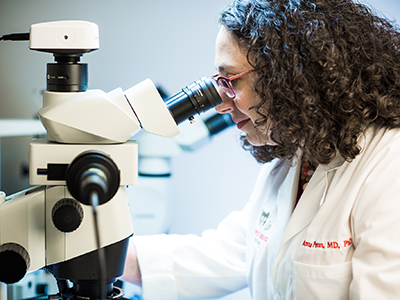Changing the game in pediatric psychopharmacology

“I realized adequate treatment in youth can prevent many of the harmful outcomes in adults who were never treated properly for their symptoms,” says Adelaide Robb, M.D.
Over three decades ago, Adelaide Robb, M.D., sat in her office with a clear goal in mind: follow a career in adult psychiatry. Her patients displayed all sorts of symptoms: generalized anxiety, depression, bipolar disorder, autism, schizophrenia.
“In the early 1990s, my patients would tell me other doctors didn’t believe in their children having bipolar disorder,” she says.
These adult patients had been sick for 5, 10 and even 15 years but had not been diagnosed or treated properly. Eventually, they started bringing their children with them, who also had similar symptoms.
“I realized adequate treatment in youth can prevent many of the harmful outcomes in adults who were never treated properly for their symptoms,” Dr. Robb says.
She soon came to another realization: there was a massive gap in the health care world – pediatric psychopharmacology. She felt the need to bridge this gap and help children, motivating her to change the course of her career. Since joining Children’s National Hospital in 1994, she’s been an unstoppable force in the pediatric psychopharmacology world, quickly changing the rules of the game.
The big picture
Pediatricians in the United States continue to grapple with a mental health crisis that was exacerbated by the COVID-19 pandemic and declared a national emergency in 2021.
Mental health plays a key role in a child’s mental, emotional and behavioral well-being. It affects the way they think, feel and act while also impacting how they handle stress, relate to their peers and make choices.
According to the Centers for Disease Control and Prevention, attention deficit hyperactivity disorder (ADHD), anxiety, behavior problems and depression are the most commonly diagnosed mental health disorders in children. While available treatments vary, over the years, data has proven how medications can play a role in improving most mental health conditions.
Children’s National leads the way
For decades, Dr. Robb has led research focused on pediatric psychopharmacology with more than 80 clinical trials. Children’s National is one of only a few sites nationwide to participate in federally funded mental health clinical trials. Major trials she has led include:
- Lexapro for major depression in youth
- Prozac for obsessive compulsive disorder
- Abilify for pediatric bipolar and schizophrenia
- Latuda for pediatric bipolar depression
- Concerta for ADHD
Dr. Robb also co-chaired the American Academy of Child and Adolescent Psychiatry’s Pediatric Psychopharmacology Initiative Committee for more than 8 years. She has also been active for more than 15 years in the American Academy of Pediatrics Committee on drugs (pharmacology).
“Since its inception in the ‘90s, pediatric psychopharmacology has changed in two major ways: First, we started to do regular testing of new medications in children and not just adults. Second, there’s been congressional and FDA mandates for testing of all medications that can be used in kids,” says Dr. Robb. “It’s no longer a guessing game – we have an evidence-based approach to children with mental illness using psychopharmacology.”
Currently, Dr. Robb is the principal investigator on several open clinical trials at Children’s National, including a study that compares the effectiveness of treating a parent with ADHD medication plus behavioral parent training (BPT) versus BPT alone on their child’s ADHD related symptoms.
Moving the field forward
Earlier this year, Dr. Robb moderated a panel on mental health and precision genomics which touched on what we know about depression, anxiety and other disorders and the future of pediatric behavioral health care.
“The goal is to give people with depression and other mental health illnesses the opportunity to go to school and function, whether they have depression, ADHD or any other disorder. This can make a huge difference in someone’s life,” Dr. Robb says.
Children’s National is uniquely positioned with a dedicated pharmacokinetic clinical team – which has greatly aided its ADHD and Learning Differences Program and most recent Addictions Program.
“We changed how ADHD was treated because our patients had early access to new trialed drugs,” says Dr. Robb. “This makes a big difference and gives children the opportunity to have better control of their symptoms so they’re paying attention and learning in school.”
Read more about our advances in Behavioral Health.





